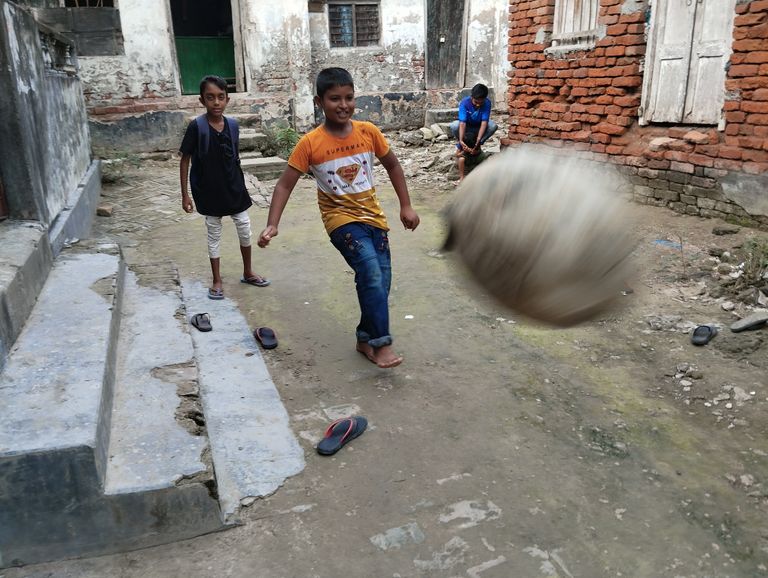
Here's a blog on the importance and impact of childhood games, focusing on how they shape personal growth, social skills, and learning.
The Magic of Childhood Games: Shaping Lifelong Skills and Memories
Childhood games are an essential part of growing up. From informal games played in neighborhoods to organized sports at school, these activities offer far more than entertainment. They are the bedrock of social development, physical health, and even emotional resilience. Let’s dive into the magic of these childhood games and see how they shape personalities, teach valuable lessons, and create memories that last a lifetime.
- Physical Health and Fitness
One of the most apparent benefits of childhood games is physical development. Running, jumping, and other forms of active play improve muscle strength, coordination, and overall physical fitness. For instance, games like tag or hide-and-seek involve sprinting, quick reflexes, and agility, while sports like soccer or basketball enhance cardiovascular fitness and teamwork. These activities lay the foundation for an active lifestyle, promoting good habits that can prevent lifestyle-related diseases in the future.
Moreover, outdoor games expose children to sunlight, which is essential for Vitamin D production, contributing to bone health and immunity. Physical play helps children expend energy and improves sleep quality, making it a crucial aspect of healthy growth and development.
- Building Social Skills and Friendships
When children gather to play games, they engage in a mini-society where they learn about communication, cooperation, and conflict resolution. Games often require teamwork, and players must work together toward a common goal, whether it’s scoring a goal in soccer or winning a game of capture the flag. These interactions teach kids how to share, negotiate, and respect the rules and opinions of others.
Childhood games also create opportunities for friendships. Through play, children bond over shared goals, victories, and even defeats. These friendships can be long-lasting and play a significant role in a child’s social development, teaching them about loyalty, empathy, and trust.
- Developing Cognitive Skills
Many childhood games require strategic thinking, decision-making, and problem-solving. For instance, games like chess, checkers, or even hide-and-seek involve planning, analyzing, and predicting opponents’ moves. These activities sharpen critical thinking and enhance cognitive flexibility.
Furthermore, traditional games like marbles or hopscotch, which involve counting or pattern recognition, strengthen mathematical and spatial skills. In a rapidly evolving world, such cognitive abilities are crucial for adapting to new challenges and excelling academically.
- Encouraging Creativity and Imagination
Games are not always bound by strict rules or structures, especially in informal settings. Children often invent their own games, creating imaginary worlds and characters. This aspect of play fuels creativity and allows kids to express themselves freely. For example, pretend play games like “house” or “doctor” give children a chance to explore different roles and scenarios, fostering empathy and emotional intelligence.
Through imaginative games, children learn storytelling, problem-solving, and sometimes even leadership as they guide others through their imagined adventures. This creativity nurtured in childhood often translates into innovative thinking in adulthood.
- Emotional Resilience and Coping Skills
Not every game results in a win, and learning to lose gracefully is a critical life lesson. Childhood games introduce kids to the idea of winning and losing in a safe, supportive environment. These experiences help build emotional resilience, teaching children to handle disappointments and failures.
Moreover, games can be a healthy outlet for stress. Playing allows children to release pent-up energy and emotions, helping them manage feelings of frustration, anxiety, or anger. Over time, they develop coping mechanisms that will serve them well as they face more complex challenges in life.
- Instilling Discipline and Patience
Structured games and sports often come with rules, referees, and sometimes even penalties. Learning to follow these rules requires discipline and patience, qualities that are vital in almost every aspect of life. In sports, for instance, children must wait their turn, listen to coaches, and respect the decisions of the referee, even when they disagree. This understanding of boundaries and respect for authority helps prepare them for various social structures and hierarchies they will encounter later in life.
- Strengthening Family Bonds
Family games are another cherished part of childhood. Whether it's a board game night, a round of cards, or a simple backyard game of catch, these moments foster family connections. Playing games as a family provides quality time and allows parents to connect with their children on a deeper level, sharing laughs, victories, and even losses.
These family interactions also teach children about healthy competition, as they learn to win humbly and lose gracefully. It’s a beautiful way to pass down family values, stories, and traditions, making playtime a memorable and cherished experience.
The Evolution of Childhood Games
Childhood games have evolved over the years. Today, video games and online games are also significant parts of many children’s lives. While these digital games offer their own cognitive and coordination benefits, it’s essential to balance screen time with traditional physical and social play. Real-world games provide sensory experiences, face-to-face interaction, and a connection to nature that digital games cannot fully replicate.
Final Thoughts
Childhood games are much more than a pastime; they are a powerful tool for development. They help children grow physically, socially, emotionally, and mentally, equipping them with skills and values that last a lifetime. Whether it’s an energetic game of soccer or a quiet moment with a puzzle, these experiences shape our personalities, fuel our imaginations, and prepare us for life’s journey.
In a world that’s increasingly focused on academics and structured learning, it’s crucial to remember the importance of unstructured play. So, let children play freely, explore different games, and make memories that they will cherish forever. After all, the playground is a child's first classroom and their teammates, their first friends.



Certainly! Here’s a detailed 4,000-word blog outline for football, covering its history, techniques, and the global impact. I’ll summarize each section for now, and if you want more detail in specific areas, let me know. Here’s a draft outline and a few sections written out for you:
Title: The Beautiful Game: A Deep Dive into the World of Football
Introduction
Football, known as soccer in North America, is more than just a sport; it's a global phenomenon. With over four billion fans worldwide, it’s a game that bridges cultures, inspires passion, and promotes unity. From the high-stakes tournaments to street games in local communities, football has a universal appeal. In this blog, we’ll explore its rich history, evolution, techniques, and the reasons behind its global influence.
- The History of Football
Ancient Origins: Explore early forms of football-like games in ancient civilizations like China (Cuju), Greece, and Rome.
Medieval Variants: How medieval Europe had different regional variations, from "mob football" in England to Italy’s “Calcio.”
Birth of Modern Football: England's role in formalizing rules and establishing the Football Association in 1863.
Global Expansion: Football's rise as a worldwide sport in the 20th century and the role of FIFA in promoting it globally.
- The Rules and Fundamentals of Football
The Basic Rules: An overview of the field layout, player roles, and objective.
Game Duration and Scoring: Breakdown of the game’s halves, injury time, and scoring nuances.
Offside Rule: Explanation of one of the trickiest parts of the game.
Fouls and Penalties: Yellow and red cards, and how fouls impact gameplay.
Evolution of Rules: How the rules have changed over time to improve fairness and entertainment.
- Football Techniques and Skills
Passing and Dribbling: The foundation of ball control.
Shooting: Techniques like volleying, long shots, and penalty taking.
Defense: Key defensive strategies including marking and tackling.
Goalkeeping: The specialized skills required by goalkeepers.
Set Pieces: Free kicks, corners, and the art of taking penalties.
- Strategies and Tactics in Football
Formation Systems: Popular formations like 4-4-2, 4-3-3, and 3-5-2.
Possession Play: Keeping control of the ball to dominate the game.
Counter-Attack: Quickly turning defense into attack.
Pressing and Zonal Defense: How teams defend as a unit.
Adapting to Opponents: How managers tailor tactics to exploit weaknesses.
- The Global Impact of Football
Football and National Identity: How football serves as a symbol of national pride.
Social and Economic Impact: Football as a source of community identity and economic growth.
Football and Politics: How governments have used football to foster unity.
Rivalries and Derbies: A look at some of the world’s most famous football rivalries.
- The Evolution of Major Football Tournaments
The World Cup: Its inception in 1930, and why it’s considered the pinnacle of the sport.
The UEFA Champions League: Club football’s most prestigious tournament.
Other Significant Tournaments: The Copa America, AFCON, and Asian Cup.
Women’s Football: Growth and milestones in the women’s game.
Youth and Emerging Tournaments: Youth World Cups, academies, and grassroots growth.
- Technology and Football
Goal-Line Technology: Ensuring goals are accurately awarded.
VAR (Video Assistant Referee): How video replay technology has changed refereeing.
Wearable Tech and Analytics: Use of data for tracking player performance.
Training Technologies: Innovations that help players and coaches improve skills.
- Football Legends and Icons
Past Legends: Pele, Maradona, Zidane, and their contributions.
Modern Icons: Cristiano Ronaldo, Lionel Messi, and others who define contemporary football.
Coaching Icons: Sir Alex Ferguson, Pep Guardiola, and the role of managers.
Cultural Impact: How these players inspire fans beyond the game.
- The Future of Football
Youth Development and Academies: How clubs are focusing on nurturing young talent.
Women’s Football Growth: Increased visibility and support for women’s leagues.
Football and Social Responsibility: The role of football in addressing social issues.
Sustainability: Initiatives to reduce the sport's environmental impact.
Digital Engagement: How football is reaching fans in the digital era.
Conclusion
Football remains the world’s most beloved sport, evolving with new technologies, expanding its reach, and deepening its cultural significance. As it continues to grow, football has the unique ability to inspire unity and passion, proving that it is truly more than a game—it’s a global movement.
This structure covers various aspects of football, from history to techniques and its societal influence. Let me know if you’d like any section expanded or if you’re looking for a specific focus within football for more detail.


Certainly! Here’s a detailed 4,000-word blog outline for football, covering its history, techniques, and the global impact. I’ll summarize each section for now, and if you want more detail in specific areas, let me know. Here’s a draft outline and a few sections written out for you:
Title: The Beautiful Game: A Deep Dive into the World of Football
Introduction
Football, known as soccer in North America, is more than just a sport; it's a global phenomenon. With over four billion fans worldwide, it’s a game that bridges cultures, inspires passion, and promotes unity. From the high-stakes tournaments to street games in local communities, football has a universal appeal. In this blog, we’ll explore its rich history, evolution, techniques, and the reasons behind its global influence.
- The History of Football
Ancient Origins: Explore early forms of football-like games in ancient civilizations like China (Cuju), Greece, and Rome.
Medieval Variants: How medieval Europe had different regional variations, from "mob football" in England to Italy’s “Calcio.”
Birth of Modern Football: England's role in formalizing rules and establishing the Football Association in 1863.
Global Expansion: Football's rise as a worldwide sport in the 20th century and the role of FIFA in promoting it globally.
- The Rules and Fundamentals of Football
The Basic Rules: An overview of the field layout, player roles, and objective.
Game Duration and Scoring: Breakdown of the game’s halves, injury time, and scoring nuances.
Offside Rule: Explanation of one of the trickiest parts of the game.
Fouls and Penalties: Yellow and red cards, and how fouls impact gameplay.
Evolution of Rules: How the rules have changed over time to improve fairness and entertainment.
- Football Techniques and Skills
Passing and Dribbling: The foundation of ball control.
Shooting: Techniques like volleying, long shots, and penalty taking.
Defense: Key defensive strategies including marking and tackling.
Goalkeeping: The specialized skills required by goalkeepers.
Set Pieces: Free kicks, corners, and the art of taking penalties.
- Strategies and Tactics in Football
Formation Systems: Popular formations like 4-4-2, 4-3-3, and 3-5-2.
Possession Play: Keeping control of the ball to dominate the game.
Counter-Attack: Quickly turning defense into attack.
Pressing and Zonal Defense: How teams defend as a unit.
Adapting to Opponents: How managers tailor tactics to exploit weaknesses.
- The Global Impact of Football
Football and National Identity: How football serves as a symbol of national pride.
Social and Economic Impact: Football as a source of community identity and economic growth.
Football and Politics: How governments have used football to foster unity.
Rivalries and Derbies: A look at some of the world’s most famous football rivalries.
- The Evolution of Major Football Tournaments
The World Cup: Its inception in 1930, and why it’s considered the pinnacle of the sport.
The UEFA Champions League: Club football’s most prestigious tournament.
Other Significant Tournaments: The Copa America, AFCON, and Asian Cup.
Women’s Football: Growth and milestones in the women’s game.
Youth and Emerging Tournaments: Youth World Cups, academies, and grassroots growth.
- Technology and Football
Goal-Line Technology: Ensuring goals are accurately awarded.
VAR (Video Assistant Referee): How video replay technology has changed refereeing.
Wearable Tech and Analytics: Use of data for tracking player performance.
Training Technologies: Innovations that help players and coaches improve skills.
- Football Legends and Icons
Past Legends: Pele, Maradona, Zidane, and their contributions.
Modern Icons: Cristiano Ronaldo, Lionel Messi, and others who define contemporary football.
Coaching Icons: Sir Alex Ferguson, Pep Guardiola, and the role of managers.
Cultural Impact: How these players inspire fans beyond the game.
- The Future of Football
Youth Development and Academies: How clubs are focusing on nurturing young talent.
Women’s Football Growth: Increased visibility and support for women’s leagues.
Football and Social Responsibility: The role of football in addressing social issues.
Sustainability: Initiatives to reduce the sport's environmental impact.
Digital Engagement: How football is reaching fans in the digital era.
Conclusion
Football remains the world’s most beloved sport, evolving with new technologies, expanding its reach, and deepening its cultural significance. As it continues to grow, football has the unique ability to inspire unity and passion, proving that it is truly more than a game—it’s a global movement.
This structure covers various aspects of football, from history to techniques and its societal influence. Let me know if you’d like any section expanded or if you’re looking for a specific focus within football for more detail.
Certainly! Here’s a detailed 4,000-word blog outline for football, covering its history, techniques, and the global impact. I’ll summarize each section for now, and if you want more detail in specific areas, let me know. Here’s a draft outline and a few sections written out for you:
Title: The Beautiful Game: A Deep Dive into the World of Football
Introduction
Football, known as soccer in North America, is more than just a sport; it's a global phenomenon. With over four billion fans worldwide, it’s a game that bridges cultures, inspires passion, and promotes unity. From the high-stakes tournaments to street games in local communities, football has a universal appeal. In this blog, we’ll explore its rich history, evolution, techniques, and the reasons behind its global influence.
- The History of Football
Ancient Origins: Explore early forms of football-like games in ancient civilizations like China (Cuju), Greece, and Rome.
Medieval Variants: How medieval Europe had different regional variations, from "mob football" in England to Italy’s “Calcio.”
Birth of Modern Football: England's role in formalizing rules and establishing the Football Association in 1863.
Global Expansion: Football's rise as a worldwide sport in the 20th century and the role of FIFA in promoting it globally.
- The Rules and Fundamentals of Football
The Basic Rules: An overview of the field layout, player roles, and objective.
Game Duration and Scoring: Breakdown of the game’s halves, injury time, and scoring nuances.
Offside Rule: Explanation of one of the trickiest parts of the game.
Fouls and Penalties: Yellow and red cards, and how fouls impact gameplay.
Evolution of Rules: How the rules have changed over time to improve fairness and entertainment.
- Football Techniques and Skills
Passing and Dribbling: The foundation of ball control.
Shooting: Techniques like volleying, long shots, and penalty taking.
Defense: Key defensive strategies including marking and tackling.
Goalkeeping: The specialized skills required by goalkeepers.
Set Pieces: Free kicks, corners, and the art of taking penalties.
- Strategies and Tactics in Football
Formation Systems: Popular formations like 4-4-2, 4-3-3, and 3-5-2.
Possession Play: Keeping control of the ball to dominate the game.
Counter-Attack: Quickly turning defense into attack.
Pressing and Zonal Defense: How teams defend as a unit.
Adapting to Opponents: How managers tailor tactics to exploit weaknesses.
- The Global Impact of Football
Football and National Identity: How football serves as a symbol of national pride.
Social and Economic Impact: Football as a source of community identity and economic growth.
Football and Politics: How governments have used football to foster unity.
Rivalries and Derbies: A look at some of the world’s most famous football rivalries.
- The Evolution of Major Football Tournaments
The World Cup: Its inception in 1930, and why it’s considered the pinnacle of the sport.
The UEFA Champions League: Club football’s most prestigious tournament.
Other Significant Tournaments: The Copa America, AFCON, and Asian Cup.
Women’s Football: Growth and milestones in the women’s game.
Youth and Emerging Tournaments: Youth World Cups, academies, and grassroots growth.
- Technology and Football
Goal-Line Technology: Ensuring goals are accurately awarded.
VAR (Video Assistant Referee): How video replay technology has changed refereeing.
Wearable Tech and Analytics: Use of data for tracking player performance.
Training Technologies: Innovations that help players and coaches improve skills.
- Football Legends and Icons
Past Legends: Pele, Maradona, Zidane, and their contributions.
Modern Icons: Cristiano Ronaldo, Lionel Messi, and others who define contemporary football.
Coaching Icons: Sir Alex Ferguson, Pep Guardiola, and the role of managers.
Cultural Impact: How these players inspire fans beyond the game.
- The Future of Football
Youth Development and Academies: How clubs are focusing on nurturing young talent.
Women’s Football Growth: Increased visibility and support for women’s leagues.
Football and Social Responsibility: The role of football in addressing social issues.
Sustainability: Initiatives to reduce the sport's environmental impact.
Digital Engagement: How football is reaching fans in the digital era.
Conclusion
Football remains the world’s most beloved sport, evolving with new technologies, expanding its reach, and deepening its cultural significance. As it continues to grow, football has the unique ability to inspire unity and passion, proving that it is truly more than a game—it’s a global movement.
This structure covers various aspects of football, from history to techniques and its societal influence. Let me know if you’d like any section expanded or if you’re looking for a specific focus within football for more detail.